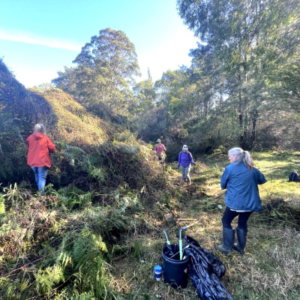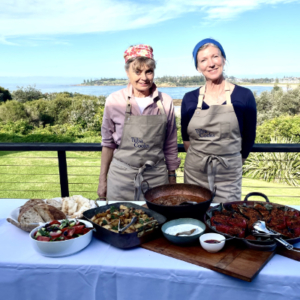Diggies working bee
 Our Diggies Landcare group is really kicking goals. A recent working bee smashed some cape ivy, a terrible problem in our valley, at Angela and Dave’s. Many hands at work with rakes got rid of a huge heap. Thanks to all who showed up.
Our Diggies Landcare group is really kicking goals. A recent working bee smashed some cape ivy, a terrible problem in our valley, at Angela and Dave’s. Many hands at work with rakes got rid of a huge heap. Thanks to all who showed up.
And thanks too to Sally Anne who brings out the Diggies Landcare Weed of the Month, which is so informative. Over the winter months we have learned about two Code Red weeds (finally some that are not on my place).
Arum lily: We have a small amount of it in Diggies that will turn into a large infestation – the type you see on the way to Tilba – if we don’t hit it now. While the flower might look pretty, it’s a serious problem in creek beds, wetlands and riparian zones because it goes feral, causes erosion and leaves a lot of nitrogen and phosphorus in the water when it breaks down which messes with freshwater mussels and tadpoles. It’s toxic and can threaten wildlife, livestock and pets, and it’s terrible for humans too because all parts of the plant contain calcium oxalate crystals that causes severe swelling of the mouth and throat if ingested so you have to be very careful when removing it. Gloves and masks are a must and do NOT compost! All plant material must be bagged and taken to green waste disposal. For a big infestation, herbicide may be the only solution.
Honeysuckle: This introduced species went feral in 1919 in Victoria. By the 1970s it had hit the Blue Mountains and by the ‘80s was on our coast. It is also in Diggies. It might smell sweet but it’s aggressive and outcompetes and smothers natives by enveloping shrubs and trees, blocking sunlight and disrupting regeneration cycles. The berries and leaves are toxic to humans and can cause skin rashes and gastro upon contact. Because it climbs into tree canopies it creates biomass and also ladders for fires which are up to eight times higher with honeysuckle than native plant fuels, so let’s smash it! How? Hand pull the vines before they seed, carefully removing roots. Mowing or slashing can suppress growth but has to be repeated a lot, and risks spreading it through cuttings. Controlled grazing can help. If it’s out of control, call Landcare.
And one more huge thanks before I sign off, this time to Jean Bentley of the Far South Coast Landcare Association. With the generous support of The Friends of the Old Bega Hospital who applied for a grant with Bendigo Bank, Jean organised for seventeen people active in Landcare to get a first aid certificate. The all-day training was held in the beautiful old Bega Hospital, with Merryn Carey and me from Diggies now trained up to do first aid should any injuries, cuts, burns or other mishaps occur when our Landcare Group is busy.

Now we know what DRSABCD means – it’s a great acronym to memorise – which Merryn suggested as Drs ABCD. Dangers (remove ‘em from the scene), Response (talk, touch and squeeze the patient), Send (for help 000), Airway (first priority is to clear it), Breathing (look, listen and feel for it), CPR (30 compressions to two breaths, 120 per minute), Defib (get it and stick it on exactly as the machine tells you).
Flick Ruby
Photos:
(Top) Dignam’s Creek Landcare group at work. Photo: Flick Ruby.
(Bottom) Landcare groups from throughout the south coast at the first aid training at the beautiful Old Bega Hospital. Photo: Flick Ruby.


